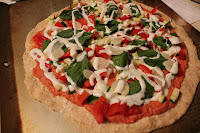My friend Kevin (who I have thoroughly brainwashed throughout the course of this project) had an all local-food/drink dinner party tonight for his birthday. Throwing a few 3'x6' plywood boards on some cinder blocks he made a make-shift table to seat 18 people in his 1 bdrm apt. Who says you need a big place or exotic foods to throw a great dinner party?
I helped him cook up some local foods for the party as follows:
Pizzas:
All Crusts:
1 1/2 cups water
2 tbsp sunflower oil
2 tsp maple sugar
4 cups flour (3 cups white, 1 cup whole wheat)
4 tsp active bread yeast1_let rise in a warm place for 30 min
2_push into bread pan (or roll out to 1/4") and rise for another 30 min
3_spread sauce on pizza
4_place ingredients on pizza
5_bake for 20 min on 425
Spicy Tomato Sauce + Goat Cheese Pizza:
sauce:
4 Roma tomatoes
2 tbps cream cheese
1/2 tsp salt
1/2 tsp dried basil
1 garlic clove
1/2 jalapeno peppertoppings:
tomatoes (guts taken out)
goat cheese
sliced garlic
hot peppers
Pear +Gorganzola Pizza
_carmelize onions in a liberal amount of oil
_toss with diced pears in frying pan for last 5 minutes
_spread mixture over pizzas
_top with chopped walnuts and garlic slices
Pesto Pizza
Pesto:
2 cups packed basil
1/2 cup pine nuts (to be substituted with local ingredient)
1 cup grated Parmesan cheese
3 cloves crushed garlic
1/4-1/2 cups sunflower oil (depending how creamy you want it)
toppings:
red peppers
sliced garlic
tomatoes
Maple Cake:
Cake:
3 3/4 cups self rising flour (for every 1 cup of all-purpose flour mix in 1/2 tsp of salt and 1 1/2 tsps of baking powder)
3/4 cup unsalted butter (softened)
1/2 cup maple sugar
3 large eggs
1 1/2 cups maple syrup
3/4 cups hot water
Butter cream frosting:1/2 cup butter
1/4 pure maple syrup
2 tbsp maple sugar
2-3 cups powdered sugar
1_Preheat oven to 350 degrees.
2_Grease and lightly flour (I use Recipe #78579) two 9-inch cake pans, then line the bottoms with waxed paper.
3_ In a large bowl, mix together the flour and the ginger and set aside.
4_In a large bowl, cream the butter and the sugar until fluffy.
5_ Add the eggs one at a time, beating until well combined.
6_Beat in the maple syrup gradually.
7_Add the flour mixture in thirds, alternating with the water, beating after each addition until smooth.
8_Pour the batter into the prepared pans; prepare a hot water bath to be placed on the rack underneath the cake pans. Bake for 30-35 minutes or until cake tests done (the toothpick test).
9_Let cakes cool in pans for 10 minutes. Remove from pans and cool completely on wire rack.
10_To make the buttercream frosting: mix butter, extract and syrup till smooth. Add powdered sugar (a few tablespoons at a time), beating on high speed (my handmixer has three speeds) till frosting reaches desired consistency.
11_When cake has cooled, ice between the layers. Ice top and sides of cake, sprinkling the top with chopped walnuts.
He asked everyone to bring a local wine or beer. Many people brought growlers of beer from local breweries which was great, no glass waste! A few people tried their hand at cooking some local dishes as well which were all excellent:
_fresh mozzerela, tomato and basil
_apple salad
_sage, basil, butter and roasted garlic crostinis
_homemade blueberry ice cream
With 36 homemade soy-wax candles, the whole dinner was by candlight, plenty of light for the whole place!










